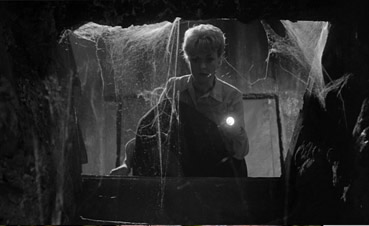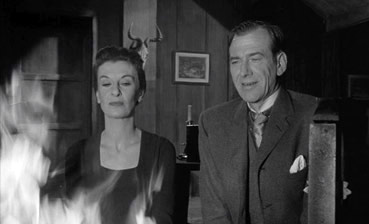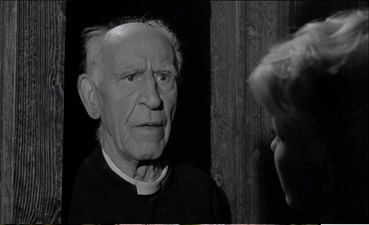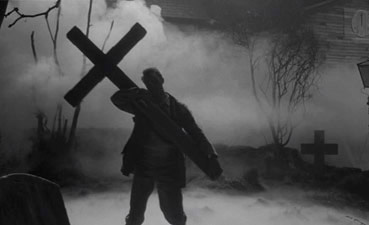| One
thing older horror movies seem to still have over their modern equivalent is that
they had better voices. From the classic monster movies of Universal
Studios through to the golden days of Hammer, horror films featured stars who made their names in
the genre and sometimes remained forever associated with
it. And they all had terrific, instantly recognisable voices,
from Bela Lugosi's Hungarian lilt and Boris Karloff's soft
English purr to the mischievous twang of Vincent Price and
authoritative baritone of Christopher Lee. Lee in particular
had and still has a commanding screen presence. His first
appearance as the Count in Terence Fisher's 1958 Dracula remains one of the best of all screen entrances, and he's one of the few
actors I instantly believed as Mycroft Holmes, a man reputed to be even
smarter than his famed brother Sherlock. He's someone I'd
still love to meet and sit with and talk to for a few hours –
I have no doubt it would be an enthralling and enlightening
experience. Lee could talk about anything and make it sound
interesting. His own life and work is a story in itself – check
out his fascinating autobiography Tall, Dark and Gruesome if evidence is required.
But
a quintessential element of Lee's voice is its Englishness,
a fact not affected by his ability to speak eight languages –
five of them fluently – and his subsequent early casting
in the odd ethnic role. And yet in John Moxey's 1960 City
of the Dead he plays an American professor. Now
some of you might be wondering why, when you have such a magnificent voice
at your disposal, you would saddle it with an American accent?
Indeed, why not cast an American actor in the first place?
Well in the case of this particular movie there are a couple
of very good reasons. First is that while the story is set
in America and thus required American characters, the film was
made by a British film company at Shepperton Studios in
London. And then there's a budget of allegedly just
£45,000, hardly enough to allow for the import of
even a small-scale American star. After The Curse
of Frankenstein and particularly Dracula,
Lee and his close friend and co-star in these films, Peter Cushing (another marvellous voice, of course), were the nearest thing the UK horror
industry had to bankable names. But Lee is also a fine, fine
actor, and no director worth his salt would pass up an opportunity
to work with him if the role suited, whatever the nationality
of the character.

The
story kicks off back in 1692 in the city of Whitewood, Massachusetts,
whose pious citizens are about to burn a woman named Elizabeth
Selwyn for witchcraft. On her way to the stake she appeals
to one of the gathered onlookers, Jethrow Keane (Valentine Dyall, yet another splendid voice), for help
and suspicion
momentarily falls on him. Has he been consorting with a
witch? He denies it and his word is apparently good enough,
so the execution proceeds. But as the pyre is ignited, Keane
begins mumbling appeals to Lucifer to save Selwyn from the
flames and the sky blackens. Before her consummation by
fire, Selwyn makes her pact with the Devil and angrily curses
the city and its inhabitants.
We then leap forward to modern times where this moment in history is being
recounted by professor Alan Driscoll (Christopher Lee) to
his students as part of a course in the history of witchcraft.
One of them, Nan Barlow (Venetia Stevenson), wants to research
her paper in more detail and asks Driscoll for a good place
to start. He suggests she visit Whitewood itself, now a
small, out-of-the-way village, and despite the protestations
of her scientifically minded brother Richard (Dennis Lotis)
and cynical boyfriend Bill (Tom Naylor), off to Whitewood
she heads.
Everything
about her approach to the village is unsettling. The
area is shrouded in thick fog, a gas station attendant she asks
for directions is surprised that anyone would actually want to
go to Whitewood, and a stranger she picks up on the way (whose
face should be familiar to the audience by this point) vanishes from her
car on their arrival. Whitewood itself offers little comfort for the inquisitive traveller.
There's Mrs. Newless (Patricia Jessel), the
frosty proprietor of the village inn, who initially claims
that there are no free rooms but on the mention of Professor
Driscoll's name suddenly discovers a vacancy. And there's
Lottie (Ann Beach), the constantly terrified and mute chambermaid,
who is scolded by Mrs. Newless when she tries to pass a
message to Nan. What might this girl know or be trying to
say? There's the sightless local priest, the Reverend Russell
(Norman Macowan), who barricades Nan's entrance to the church
and urges her to leave. And there are the citizens themselves,
who drift through the fog at night and stop to stare silently
at Nan as she passes. An ideal holiday destination this
clearly is not. The only friendly face she encounters is that of
the Reverend's granddaughter Patricia, the recently arrived
proprietor of a bookshop that I can't imagine has ever
had a single customer until Nan walks in. Even she can't afford
to buy the book she wants, a weighty tome on witchcraft
that she ends up borrowing and becomes so enraptured by
that she fails to spot the warnings it offers regarding her
own possible fate.

There
can't be many horror fans who will taken by surprise by much of the above. Modern day tales of witchcraft require characters
to be sceptical and walk blindly into situations that the audience
will recognise instantly as dangerous. As genre devotees we often
execute an about-face on belief when it comes to our engagement
with a movie – in the real world, if someone tells you that
a cup fell from a table because a ghost pushed it off youwould probably mock them, but if it happens in a genre film then of course it was a ghost, you silly sceptical fool. I've got a cellar
and a loft in my house and I'll happily go into either with just a lamp
to guide me, but the moment someone does likewise in a horror
movie, their daftness almost has me screaming at the screen. And so
it is with Whitewood. We've seen it before and we thus know
what's going to happen, but one strengths of City of the
Dead, especially for its time, is that it lulls you into
a false sense of certainty and then blindsides you. It's
a turn of events that warrants a comment or two, but also
one that should not be revealed to newcomers. And so...
Now
listen. If you are planning to see the film and don't want
to know how the plot unfolds, then I seriously suggest you
skip the next paragraph. Really. This discussion is for those
who know the film or its plot. Look, I'll make it easy for
you – just click here and the
page will scroll down past it.
Are we alone now? Good. Those
of you who are familiar with the way the film pans out will know that
over halfway in it throws a curve ball by unexpectedly killing off what we have come to assume is its central character, sacrificed by the Whitewood coven as
part of their ritual of everlasting life. The similarity
to the same but more widely celebrated carpet-pull
executed by Alfred Hitchcock in Psycho has been widely remarked on, but the parallels don't end
there. Blonde-haired Nan travels from home to an out-of-the-way
spot to stay at a dodgy hotel and is killed by the establishment's
proprietor. The disappearance is investigated by two men
and a woman, a group that includes a sibling and a boyfriend,
who are falsely informed by her killer that Nan departed
the day after she arrived. Two of them even approach a figure
at the end and get a shock and scream when it's face is
revealed. Wow, those co-incidences are piling up, aren't
they. The obvious supposition is that there is some serious
borrowing going on here and that the film is trading on
the success of Hitchcock's masterpiece. There's just one
thing: the two films were shot almost simultaneously in
different countries with little knowledge of the other's
existence, let alone content. Uncanny, huh?
OK, we're back on safe ground.
No more serious spoilers, I promise.
The
story provides the framework, but City of the Dead's
well-deserved status as a cult favourite lies in its execution,
notably John Blezard's creepily suggestive art direction
and Desmond Dickinson's extraordinary monochrome cinematography. Between them they make it feel almost as if
Nan has stepped out of the real world and into one created
from her own nightmares, as figures stand motionless in
thick fog or shuffle silhouetted into the graveyard for
a midnight mass. Even the flickering of firelight as
Nan first enters the inn has strangely demonic overtones, while her descent into the blackness of cellar below her room, guided
only by a narrow beam of light from her torch, is as tense as any
such scene in more recent horror cinema. The imagery and
atmosphere don't just belie the film's budget, they make
a mockery of it – rarely if ever have you seen a horror
film that looks or feels quite like this.

But
if Dickinson and Blezard give the film its distinctive visual
style then all credit to first-time feature director John
Moxey for knowing just what to do with it. His camera placement repeatedly intensifies Whitewood's creepiness,
from his arrangement of multiple characters in frame to
his thoughtful and effective use of personal viewpoints (Nan's arrival
is in town is made all the spookier by the motionless figure
distantly illuminated by the car's headlights), while his
inventive use of editing delivers a John Carpenter-esque
frisson when an eerie late night dance comes to the sort
of abrupt ending that only film can deliver.
The
cut-it-with-a-knife atmosphere is very effectively counterbalanced
by performances that have conviction but are also, for the
most part, nicely underplayed, no mean feat for a partly
English cast having to work with (mostly convincing) American
accents. Venetia Stevenson (whose accent is real) in particular
makes for a likeable and believable Nan, while Lee quietly
shines as the professor who may be more than he seems, and Patricia Jessel walks a fine line as the sinister Mrs. Newless,
nicely avoiding the sort of melodramatic interpretation
such a role almost invites. Only Tom Naylor as boyfriend
Bill Maitland seems to struggle a little, but he makes amends in
a strikingly visualised climax in the Whitewood graveyard.
The
first production by independent company Vulcan, who after
three films became Hammer's only real rival Amicus, City
of the Dead is a fine example of the sort of restrained,
imaginative and smartly made British horror film (Sidney
Hayers' 1962 Night
of the Eagle was another) that should have
led the way forward for the genre. But the ball was dropped
and picked up by the likes of Roman Polanski and George
Romero, whose 1968 Rosemary's Baby and Night of the Living Dead marked the end
of UK horror film dominance and the beginning of a new wave
that would put America back on top.
This
review looks at both the VCI US DVD and the new Redemption
UK 2-Disc Special Edition. Although the latter appears to
have been sourced from the former, there are a couple of
significant differences. I'm willing to concede that the
difference in extra features may be down to licensing issues,
but before we get to that there's an issue that I will accept
no excuse for.
Sourced
from a good quality print, the anamorphic 1.66:1 transfer
on the VCI disc is first rate. Initially it seems almost
as if pure blacks and whites are absent in favour of a rich
palette of grey tones, but once we get to modern night-time Whitewood
the contrast is bang on, with deep, solid blacks
and well rendered highlights that handsomely showcase Desmond
Dickinson's gorgeous cinematography. There are a few dust
spots, but you rarely even notice them, and the print is
otherwise clear and the detail impressively crisp. For a
low budget film of this vintage, this is an exceptionally
good job.

The
Redemption disc has been sourced from what looks like the
same digital master, but has undergone NTSC to PAL conversion
that causes blurring on movement and just takes the edge
of the contrast found on the VCI disc. But the real crime
committed here is that the widescreen transfer is letterboxed
rather than anamorphic, reducing the resolution
by a third.
Given the high quality of the anamorphic transfer on Redemption's Sacred Flesh DVD and the fact that VCI's transfer was mastered from a
35mm print owned by the British Film Institute, this is
both surprising and hugely disappointing.
The
2.0 mono soundtrack is the same on both releases – functional
and clean, with only a slight hiss to show it's age.
The
extra features on the Redemption disc are consigned to disc
2 (more on that later) and have largely been licensed from
the VCI original. Most of the extras on the VCI disc have
been included on the Redemption disc, but with two major
exceptions.
Commentary
by Actor Christopher Lee (VCI disc only)
Before you get too excited, a couple of irritating misjudgements have been
made by those recording and mixing the commentary that stops this from being
the killer track it should have been, and that's the decision
to sit Mr. Lee in front of a film he hasn't seen for over
40 years and shut off the soundtrack. Lee thus repeatedly
wonders out loud what is being said by the characters and
is bemused by actions that would be clear if he could hear
what they were saying. In an insult to injury move, the
soundtrack has been included for our benefit, and is occasionally
loud enough to compete with Lee for our attention. But
in other respects this is an enjoyable and very worthwhile
inclusion. Lee spends a little too much time describing
what we're watching, but moderator Jay Slater regularly
interrupts with questions that give rise to some fine stories
and interesting background detail on the filming.
Anecdotes abound and are not consigned to this film, his
work with the likes of Tim Burton, George C. Scott and even
George Lucas also getting a little coverage. There are some
engagingly humorous moments, not least when the subject
of Star Wars comes up and Slater specifies Attack of the Clones. "Yes, well..."
Lee begins in response to a title he was not impressed with,
"...you'll have to speak to George about that." He
also discusses the nature of good and evil in the modern
world, and suggests, contrary to popular opinion (but agreeing
with Camus in his review of Casino
Royale), that Timothy Dalton was the actor
best qualified to play James Bond. "Ian Fleming was
my cousin," he reminds us, "so I know what Bond
was supposed to be."
Commentary
by Director John Moxey (VCI disc only)
VCI's second coup is to convince John Moxey to come into the studio
to share some memories of the shoot, and although there
are quite a few long pauses early on, the track gets busier
as it progresses and proves an involving listen. There's
plenty of information on the actors and a fair amount on
the technical details, notably Dickenson's lighting and
photography – "Every first-time director should be
lucky enough to have such a great cinematographer work for
him," he remarks. He fills us in on the work he's done
since, and offers an opinion on some subsequent genre films,
some of which he likes – Night of the Living Dead, The Exorcist, Jaws, Rosemary's
Baby – but others he's less happy with – The
Shining, The Blair Witch Project, Friday the 13th, and just about anything that
throws gore at the screen. It's all good stuff, and adds
to the VCI disc's completist feel.
Interview
with Christopher Lee (45:07)
Lee is interviewed by fan-faced
genre critic Brad Stevens, who also supplies the noddies
to cover up the editing. With his work on City of
the Dead covered in the first commentary, Lee here
looks back at his career and the directors and actors he's
worked with, and gets seriously miffed at his continued
typecasting by the media. There's a little bit of rambling
and repetition at the end, but Lee is one of the most interesting
talkers out there, so I'm not complaining. One particular
note of interest is that the interview was conducted shortly
after the completion of Lord of the Rings but before its release – Lee predicts it's going to be huge.

Interview
with John Moxey (28:18)
The lively Moxey revisits some of the ground covered in
his commentary, but there's enough new stuff here to keep
this interesting, especially the details of his early career
and his subsequent work in America.
Interview
with Venetia Stevenson (19:50)
The actress recalls her role as Nan Barlow and suggests
that the main things she brought to it was an American accent.
She covers her career, including her abandonment of acting
to become a mother and later a production manager – the
work she is most proud of is Walter Hill's Southern
Comfort.
Original
Theatrical Trailer (1:31)
Includes the final shot of the film and giveaways, so don't
watch this first.
Photo
Gallery (VCI disc only – 3:23)
A rolling gallery of stills, behind-the-scenes photos and
promotional material.
Biographies (VCI disc only)
Slowly scrolling biographies and filmographies for John
Moxey, Venetia Stevenson, Christopher Lee, Patricia Jessel,
Dennis Lotis and Betta St. John. Dennis Lotis's biography
is spectacularly brief on detail.
Star
and Director Biographies (Redemption disc
only)
Not biographies but filmographies for Christopher Lee, Patricia
Jessel, Denis Lotis and John Moxey.
Promo
Art (Redemption disc only)
10 pages of promo material.
Stills (Redemption disc only)
7 stills, not that big.
A
memorable and very stylish British horror film that too
few appear to have seen. Well now's your chance. A 2-disc
Special Edition may sound like a fan's wet dream, but Redemption
has fumbled the ball here, a revamp of VCI's disc that
loses two of its best extra features and the anamorphic
transfer. This is particularly galling
given that the American release was mastered from a British
film print, only to be standards converted and downgraded
for the UK DVD release. And it's becoming an old gripe, but
how is it, exactly, that VCI can fit more onto one disc
that Redemption can on two?
|